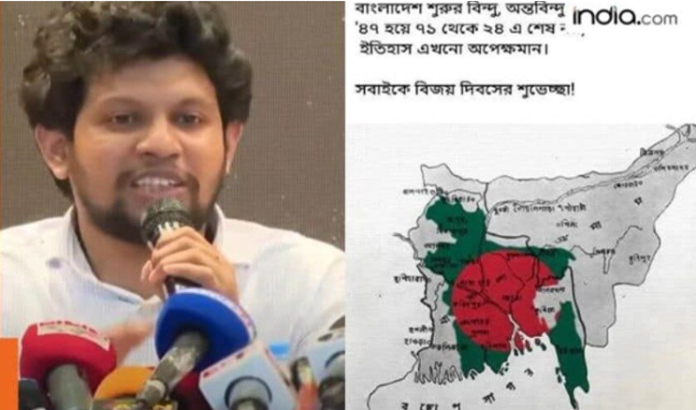On April 29, 2025, Fazlur Rahman, former Major General of Bangladesh army, wrote in Bangladeshi on his Meta account, “If India attacks Pakistan, Bangladesh should occupy the seven states of North-eastern India. I think it is necessary to start discussions with China on a joint military arrangement in this regard.” This could be viewed as the doggy feeling like a tiger in its lane, but the fact that as an aide to Muhammad Yunus, Chief Advisor to the Interim Government of Bangladesh, in December 2024, Yunus appointed Rehman as Chairman of the National Independent Commission assigned to investigate the killings in the Bangladesh Rifles revolt of 2009, which makes it somewhat official.
Three days later, on May 2, the Yunus government disassociated itself from Rahman’s remarks. However, in March 2025, Yunus had said in Beijing that India’s seven north-eastern states, which share a nearly 1,600-km border with Bangladesh, are landlocked and have no way to reach the ocean except through Bangladesh; Dhaka is the “only guardian” of the Indian Ocean in the region. Earlier on December 16, 2024, Mahfuz Alam, a radical student leader and then serving as ‘minister’ in Bangladesh’s interim government, issued a provocative map showing Bengal, Assam and Tripura as part of Bangladesh.
Bangladesh’s fixation on India’s northeast is not new. Before becoming the prime minister of Bangladesh, Sheikh Mujibur Rehman wrote in his book ‘Eastern Pakistan – its Population and Economics’, “Because Eastern Pakistan must have sufficient land for expansion, Eastern Pakistan must include Assam to be financially and economically strong.” However, much water has flown under the bridge since Mujibur Rehman wrote that book; India demolished East Pakistan and helped Mujibur Rehman become the prime minister of Bangladesh; something that Yunus and his radical Islamist followers refuse to acknowledge.
The US aim of regime change in Bangladesh is to destabilise South Asia, using Bangladesh’s lack of resources and burgeoning population to incite radical Islamists against India. China would get sucked into any India-Bangladesh war, which would benefit the US economically and strategically. The repercussions on India must be viewed together with the instability in Manipur, and an influx of Chin from Myanmar into Mizoram
The CIA-engineered regime change in Bangladesh, rapid rise and expansion of Islamic radicalisation and ISI consolidation in that country, genocide against Hindus, Bangladesh-Pakistan terror nexus, Pentagon in direct contact with the Yunus regime, China-Pakistan arming the Yunus regime, Bangladesh-China bonhomie, and Dhaka’s mischief on its border with India, was covered in these columns earlier. The US aim of regime change in Bangladesh is to destabilise South Asia, using Bangladesh’s lack of resources and burgeoning population (as mentioned in Mujibur Rehman’s book) to incite radical Islamists against India on the plank of Islamic jihad. China would get sucked into any India-Bangladesh war, which would economically and strategically benefit the US.
The US has another use for Yunus now; Bangladesh army to support America’s proxy war against the Myanmar military junta in Myanmar’s Rakhine state – logistics and tactical support (drones included) to the anti-junta coalition, including Arakan Army (AA) and the Chin National Front – CNF; logistics support base near Teknaf and drone operations from Cox’s Bazar airport. The report talks of AA and CNF representatives meeting US officials and the presence of Ataullah Abu Ammar Jununi, chief of the Arakan Rohingya Salvation Army (ARSA) in Dhaka. ARSA, having links with Pakistan’s ISI and Lashkar-e-Taiba (LeT), is responsible for mass Hindu killings in Myanmar in recent years.
The interesting part is that China is arming both the military junta in Myanmar as well as anti-junta forces. However, the AA threatening takeover of Sittwe City and Port is not in the interest of China; with evidence of increasing Chinese military presence and influence in Myanmar, including in the Sittwe region. What the US wants the Bangladesh army to do (assisting anti-Junta forces) amounts to countering Chinese influence in Myanmar. Yunus, therefore, must hunt with the hounds and run with the hare (as Pakistan is doing) in order to appease both the US and China. Whether the strategic importance of Bangladesh is the same as Pakistan is debatable, but the US also gets to keep India under pressure by keeping India’s eastern flank unstable; the repercussions on India must be viewed together with the instability in Manipur, plus Mizoram having a large influx of Chin from Myanmar.
During his visit to China in March 2025, Yunus sought a 50-year Chinese master plan for Bangladesh’s river management, not just the USD one billion Teesta Multipurpose Project involving dredging, creating reservoirs and embankments, and satellite townships on both sides of the river. In addition, Bangladesh has renewed an MoU with China’s state-run PowerChina for a project costing USD one billion; which includes constructing, expanding, upgrading, and renovating 100 substations, over 1,000 km of transmission lines, and seven inspection-maintenance centres. Both the PowerChina project and the Teesta Multipurpose Project are close to India’s Chicken’s Neck area.
Union Home Minister Amit Shah told Parliament on March 27, 2025, that fencing work of 450 km along the India-Bangladesh border is pending because the West Bengal government is not giving land for it. If this is the state of affairs, how can we possibly have the spine to deal with Pakistan’s terrorism other than some tactical actions and announcing we will chase the terrorists and perpetrators to the end of the Earth?
Notably, Yunus has invited China to build an air base in Bangladesh’s Lalmonirhat district, with a Pakistani firm to work as the subcontractor. The Lalmonirhat district is situated at the northern border of Bangladesh. It is a part of the Rangpur Division, which was recently visited by senior Pakistani military and ISI officials. With the US and China backing Yunus for playing their geopolitical prostitute, Yunus and his cohorts are cocking a snook at India, more so possibly because China illegally claims Arunachal Pradesh. Yunus, who was earlier talking about holding elections in Bangladesh at the end of 2025/early 2026, is already talking about June 2026. Obviously, he wants to hold on to power for as long as he can with American and Chinese backing. To appease the US, he has awarded Elon Musk the license for Starlink cover to Bangladesh; which will also help illegal infiltration, as well as infiltration of terrorists to carry out terrorist attacks in India. Moreover, Yunus has asked for Chinese drones and China’s drone technology, which would add to the formidable challenges we face.
India has stopped allowing trans-shipment facilities to Bangladesh at Indian ports, which hits Bangladesh financially, but that may not be enough for the state-sponsored Islamist radicals of Bangladesh who are openly baying for jihad against India. Unfortunately, the government is lackadaisical about border security. Union Home Minister Amit Shah told Parliament on March 27, 2025, that fencing work of 450 km along the India-Bangladesh border is pending because the West Bengal government is not giving land for it. If this is the state of affairs, how can we possibly have the spine to deal with Pakistan’s terrorism other than some tactical actions and announcing we will chase the terrorists/preparators to the end of the Earth? Why can’t a buffer zone be established and those in the buffer zone relocated elsewhere? With all the noise against colonial practices, why is the government practicing the colonial policy of “divide and rule”; keeping the Army at arm’s length and propping up police forces? The need of the hour is to place at least our borders with Bangladesh and Nepal under the Army, if not all land borders – like China. Can the government rise above petty and vote-bank politics to do so?
With all the noise against colonial practices, why is the Union government practicing the colonial policy of ‘divide and rule’; keeping the Indian Army at arm’s length and propping up police forces? The need of the hour is to place at least our borders with Bangladesh and Nepal under the Indian Army if not all land borders – like China. Can the government rise above petty and vote-bank politics to do so?
Looking at the trajectory Bangladesh is moving along, India needs a multi-faceted, multi-level approach (including grey zone operations) to deal with the threat. On top of the agenda should be the Ganga Water Treaty, which is crucial for Bangladesh’s economy, which expires next year – 2026. As an upper-riparian state, China does not have a water-sharing treaty with any nation and has weaponised water. In the aftermath of the Pahalgam massacre, India has held the Indus Water Treaty “in abeyance”, which we should actually exit. As the upper-riparian state, there is no reason why India should renew the Ganga Water Treaty next year, or hold it “in abeyance” earlier if the Yunus-led government continues to play tricks and misbehave. India must move all Rohingya refugees to detention camps, in accordance with the Immigration and Foreigners Bill, 2025, and arrange for their early repatriation. India must also convey to Dhaka that if it continues to act adverse to Indian interests, what is happening to Pakistan could be applied to Bangladesh, like; pruning the Bangladesh High Commission in New Delhi; Bangladeshi nationals (visitors, tourists, students, under medical treatment) asked to leave; no trade; closure of Indian airspace to Bangladesh, and the like. It is about time India develops a more muscular foreign policy for its immediate neighbourhood, with Yunus bent upon building an anti-India Bangladesh-China-Pakistan nexus.
Finally, to cater to extreme contingencies, India must keep plans ready for broadening the Siliguri Corridor, as well as to carve out an enclave out of Bangladesh for the Hindus (1.3 crore), Buddhists (10,00,000), Christians (5,00,000) and other religious minorities being persecuted by the Yunus regime.
The author is an Indian Army veteran. The views expressed are of the author and do not necessarily reflect the views of Raksha Anirveda






